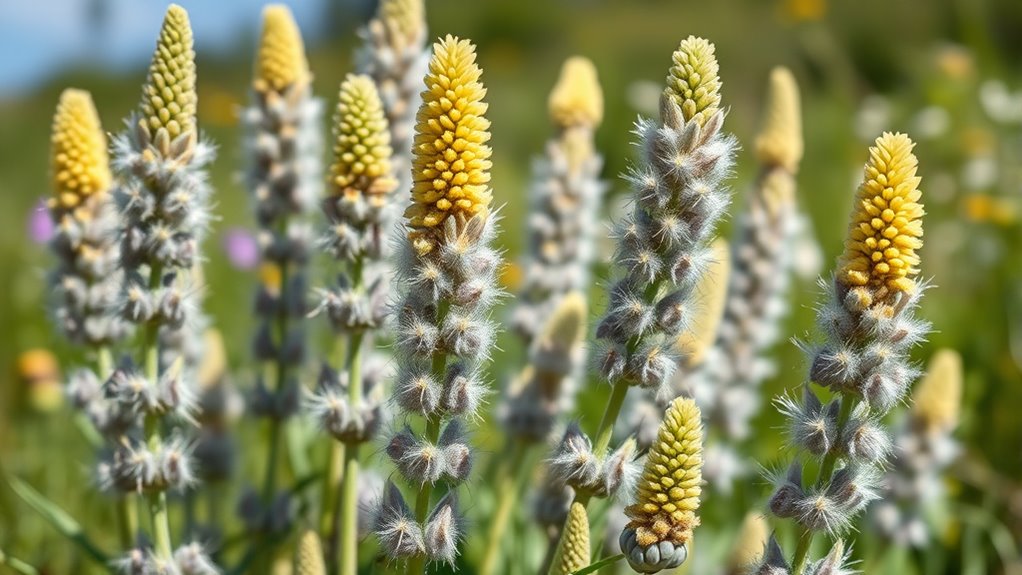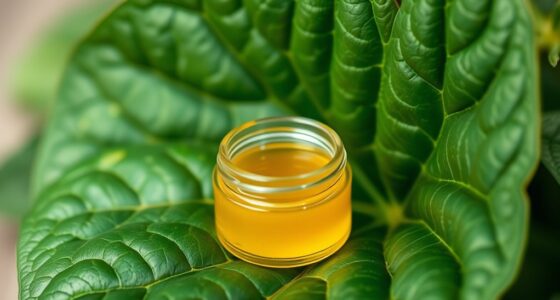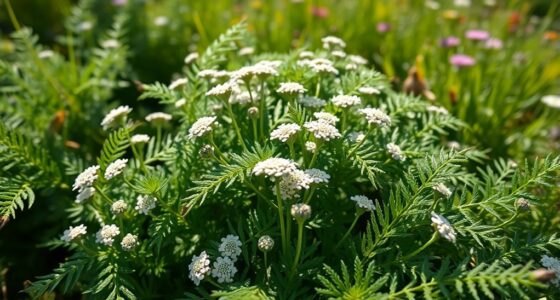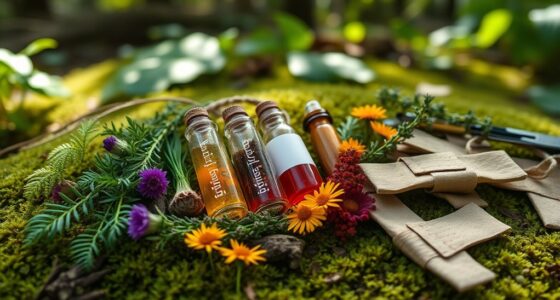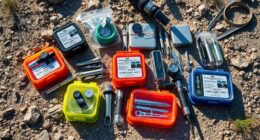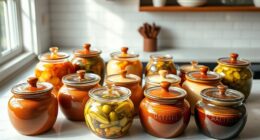To identify mullein, look for tall, sturdy stalks topped with bright yellow, tubular flowers, and thick, velvety leaves that grow in a rosette at the base, often fuzzy and scalloped. It thrives in dry, open areas like fields or roadsides. When harvesting, only pick mature leaves and flowers, and dry them properly for teas or tinctures. If you keep exploring, you’ll discover how to use mullein safely for respiratory support.
Key Takeaways
- Recognize mullein by its tall, fuzzy stalks, broad velvety leaves, and bright yellow, tubular flowers in summer.
- Harvest mature leaves and flowers sustainably, avoiding roots, and dry them in ventilated areas for medicinal use.
- Use mullein in teas, tinctures, or infusions to soothe coughs, reduce inflammation, and clear mucus from respiratory pathways.
- Be aware of potential allergies and interactions; consult a healthcare professional before use, especially if pregnant or on medication.
- Incorporate mullein with complementary herbs like eucalyptus or peppermint for enhanced respiratory support safely.
Recognizing Mullein in Its Natural Habitat
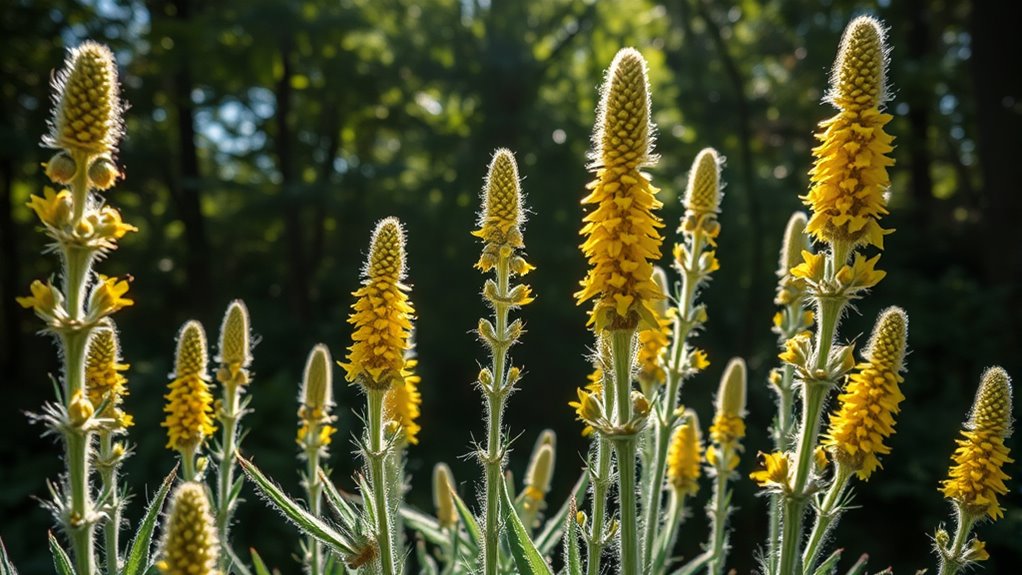
Mullein is easily identified by its tall, sturdy stalks covered in soft, fuzzy leaves. You’ll find it thriving in wild habitats like open fields, roadsides, and disturbed areas. Its plant distribution spans across North America, Europe, and Asia, often appearing in dry, well-drained soils. As you explore natural landscapes, look for its rosette of large, velvety leaves at the base, followed by the erect flowering stalks that can reach up to 6 feet. Its bright yellow flowers bloom in dense clusters along the stalks during summer months. Recognizing mullein in its native environment helps you understand its adaptability and widespread presence, making it easier to locate for herbal use or observation in the wild. Environmental regulations may also influence where you can sustainably harvest wild mullein.
Distinguishing Mullein From Similar Plants
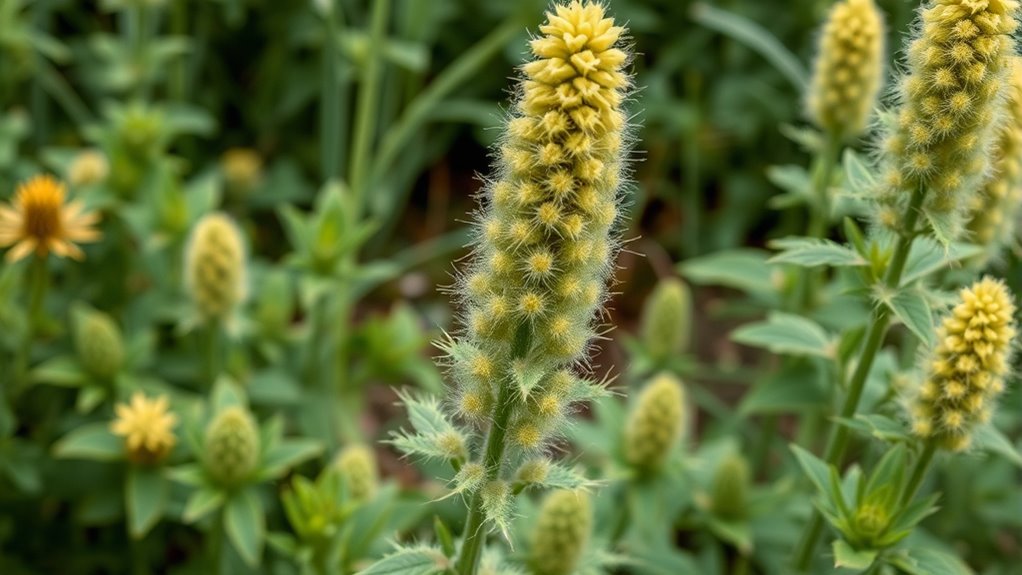
To tell mullein apart from similar plants, pay close attention to leaf shapes; mullein’s leaves are tall, fuzzy, and rosette-shaped. Notice the flowers and stems—mullein has yellow, fuzzy flowers on tall, sturdy stalks. Recognizing these differences helps guarantee you’re using the right plant for respiratory relief. Additionally, understanding the plant identification features ensures safe and effective use of mullein for health purposes.
Leaf Shape Differences
While many plants may look similar at a glance, paying attention to leaf shape is key to distinguishing mulleins from their look-alikes. Focus on leaf margin differences, as mulleins typically have large, velvety, and slightly fuzzy leaves with scalloped or toothed edges. In contrast, similar plants might have smoother or more sharply serrated margins. Leaf texture variations are also telling; mulleins often feature soft, dense hairs that give the leaves a plush feel. Notice their size—mullein leaves tend to be broad and elongated, sometimes up to a foot long. Additionally, examining the leaf arrangement can help confirm identification, as mulleins usually have a basal rosette with leaves radiating from the base. By observing these details, you can confidently identify mulleins and avoid confusing them with other plants. Keep an eye out for these subtle but important leaf characteristics.
Flower and Stem Variations
Flower and stem variations are essential clues for telling mulleins apart from similar plants. Mullein typically features bright yellow flowers, though some species may have orange or red hues, making flower color a useful identifier. The flowers grow in dense clusters on tall, erect stems that can reach up to 6 feet, depending on the species. In contrast, plants like foxglove or plantain have different flower arrangements and stem heights. Mullein’s stems are sturdy and hairy, often covered with dense woolly hairs, which also helps distinguish it. When identifying mulleins, pay close attention to the vibrant flower color and the substantial, tall stems, as these features set it apart from other plants with similar foliage but different flowering and growth characteristics.
Identifying Mullein by Its Unique Foliage and Flowers
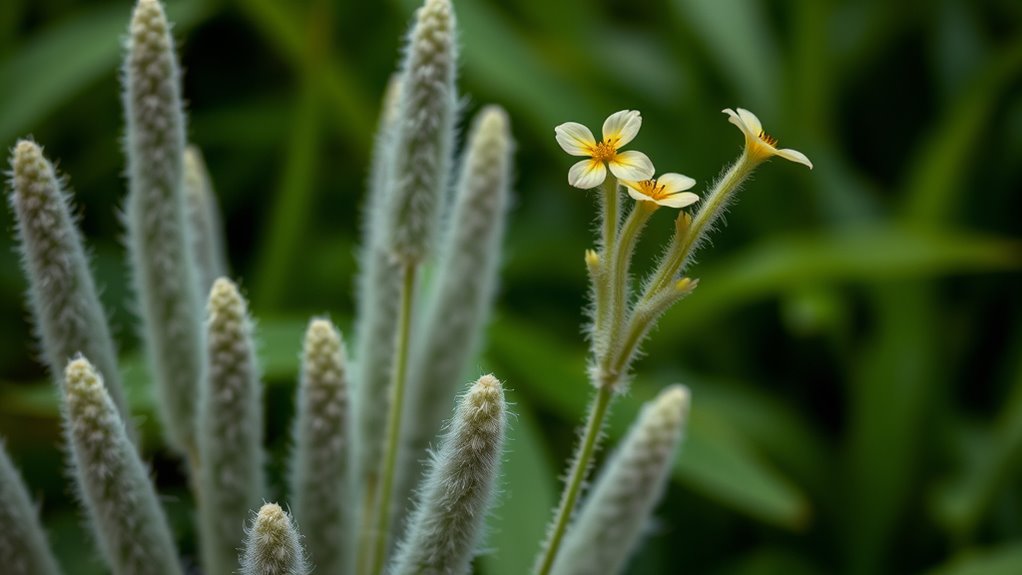
You can identify mullein by its tall, fuzzy leaves that grow in a rosette at the base and extend along the stem. Its flowers are bright yellow, tubular, and form dense spikes during summer. Noticing these distinctive foliage and flower features makes recognizing mullein straightforward. Additionally, understanding plant identification techniques can help confirm its presence in natural settings.
Distinct Leaf Features
Mullein is easily recognized by its distinctive foliage and flowers, which set it apart from other plants. Its leaves are large, soft, and velvety to the touch, giving them a unique leaf texture. The leaves grow in a rosette at the base and are cordate, with a broad, rounded shape. The margin serration features finely toothed edges that are noticeably serrated but not overly sharp. These serrations help you identify mullein even from a distance. The leaves are often covered in dense, woolly hairs, adding to their soft appearance. When examining the plant, look for the contrast between the lush, fuzzy leaves and the upright flower stalks. Recognizing these leaf features ensures you’re correctly identifying mullein for medicinal use or cultivation. Additionally, the plant’s distinctive leaf features are crucial for proper identification in the wild or garden.
Notable Flower Characteristics
Have you noticed the tall, upright flower stalks that rise above the soft foliage? These characteristic spikes are covered with small, fuzzy, yellow-orange flowers that bloom in dense clusters. The flowers’ unique shape and vibrant color make Mullein easily recognizable. Their medicinal properties have been valued for centuries, especially in herbal applications aimed at respiratory health. The flowers contain compounds that soothe irritated mucous membranes, making them useful in teas, tinctures, and salves. When identifying Mullein, look for these distinctive flower stalks that stand out against its broad, velvety leaves. The flowers not only aid in recognizing the plant but also highlight its importance as a natural remedy. Their presence signals the plant’s readiness for harvesting and herbal use. Additionally, high contrast ratios in visual displays help in clearly observing the plant’s details during identification.
Harvesting Mullein Safely and Responsibly
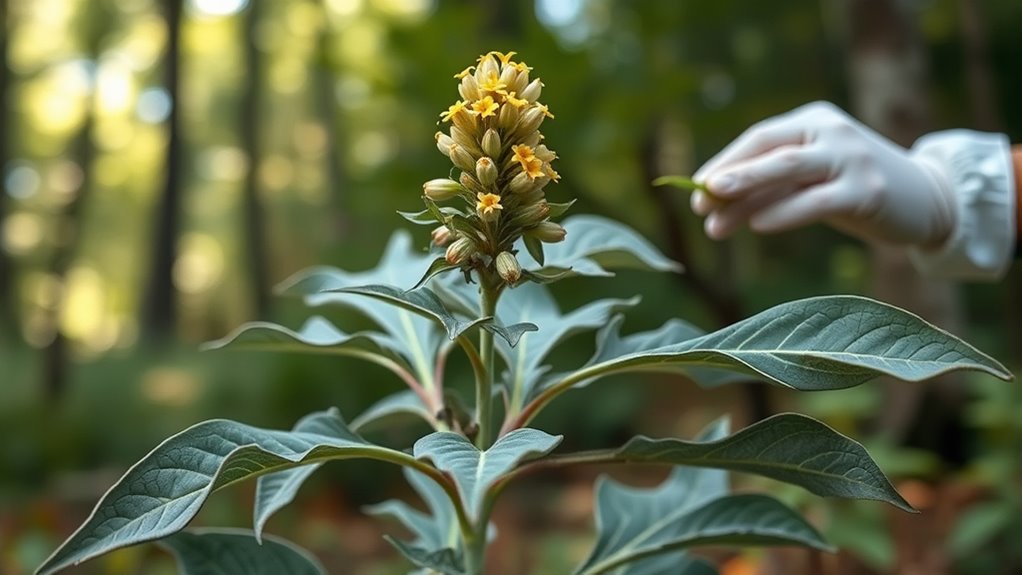
Harvesting mullein requires careful attention to guarantee both safety and sustainability. When you engage in wild harvesting, always identify the plant accurately to avoid confusion with toxic species. Practice sustainable collection by harvesting only mature leaves and flowers, leaving enough behind for the plant’s health and growth. Never overharvest from a single patch, and respect local regulations or landowner permissions. Avoid digging up the root unless necessary, to prevent damaging the plant. Using clean tools helps prevent contamination. By following these guidelines, you assure mullein populations thrive for future use. Proper identification techniques are essential for safe and effective harvesting.
Preparing Mullein for Use: Teas, Tinctures, and Infusions
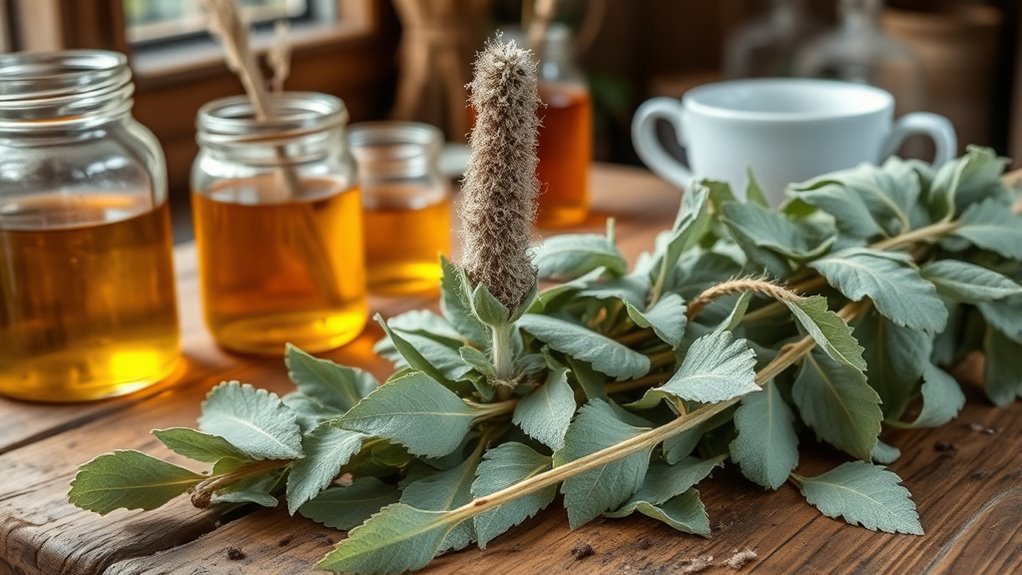
Preparing mullein for use involves selecting the appropriate form—such as teas, tinctures, or infusions—and guaranteeing it’s properly processed. To do this, focus on good Mullein cultivation practices to gather healthy, vibrant leaves and flowers. Dry the plant in a well-ventilated area, protecting it from direct sunlight to preserve its medicinal properties. Once dried, you can create teas by steeping crushed leaves or flowers in hot water, or prepare tinctures by soaking the plant material in alcohol. Proper Mullein conservation is essential to maintain its potency over time. Always store your preparations in airtight containers away from light and moisture. This careful process ensures you get the most benefit from Mullein’s respiratory-supporting qualities while respecting sustainable harvesting methods. Additionally, understanding the importance of emotional support can be beneficial when incorporating herbal remedies into your wellness routine.
Traditional and Modern Uses of Mullein for Respiratory Relief
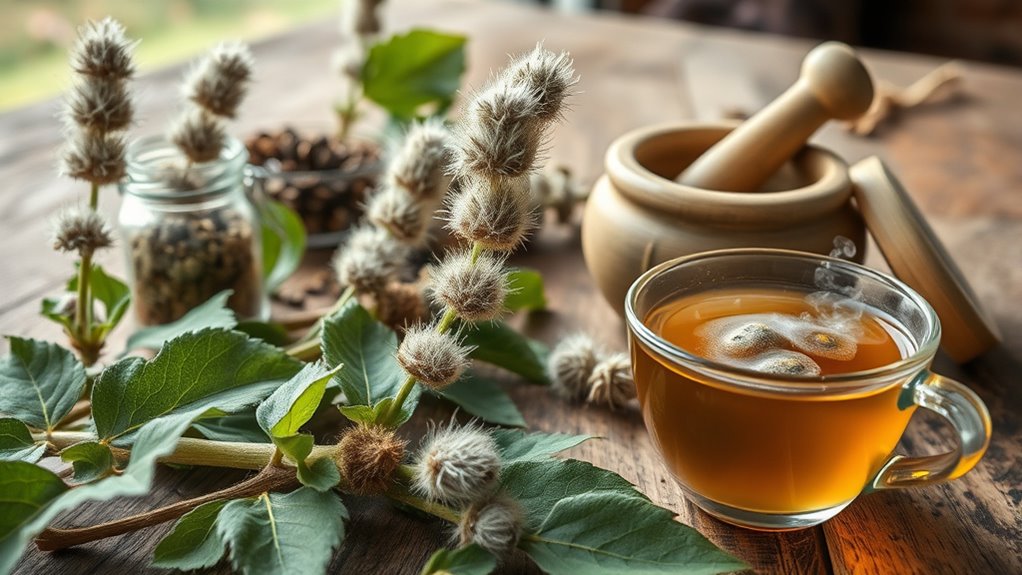
Mullein has been valued for centuries as a natural remedy for respiratory issues, seamlessly blending traditional practices with modern herbal medicine. Its renowned medicinal properties include soothing coughs, reducing inflammation, and clearing mucus. Historically, mullein was used in poultices and infusions to treat bronchitis, asthma, and chest congestion. Today, many herbalists incorporate mullein into remedies for respiratory relief, recognizing its effectiveness backed by centuries of use. You can enjoy its benefits through teas, tinctures, or inhalations. Its gentle, soothing nature makes it suitable for various respiratory conditions. By understanding both its historical uses and modern applications, you harness the full potential of mullein to support your respiratory health.
Mullein has been a natural remedy for respiratory issues, soothing coughs, reducing inflammation, and clearing mucus for centuries.
- Soothing coughs and inflammation
- Clearing mucus and easing congestion
- Supporting respiratory system naturally
Precautions and Potential Interactions When Using Mullein
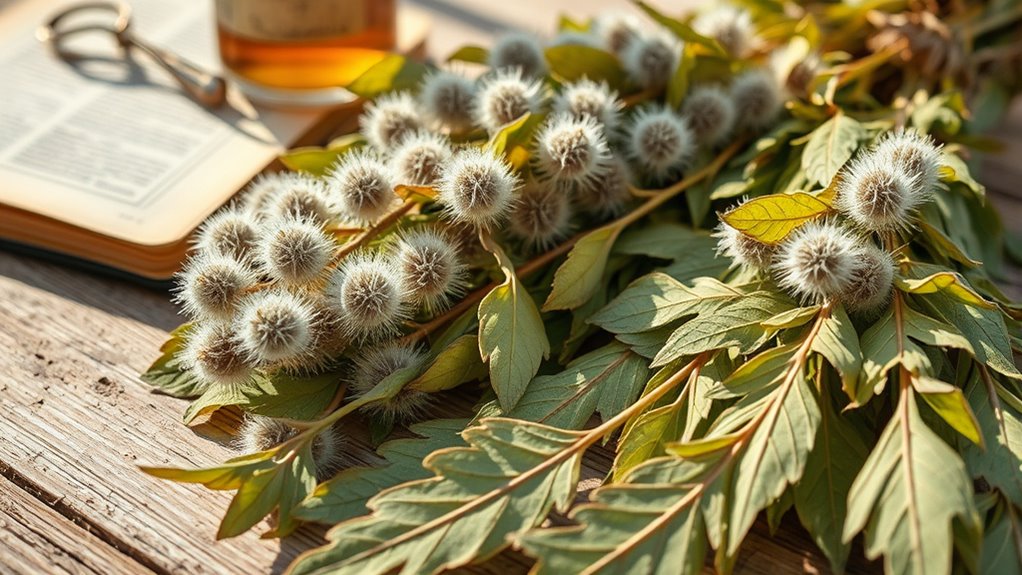
While mullein is generally safe for most people, it’s important to be aware of potential precautions and interactions before incorporating it into your respiratory health routine. Some individuals may experience allergy warnings, especially if they have sensitivities to plants in the same family, like foxglove or dusty environments. Mullein may also cause mild skin irritation when handled directly. Regarding drug interactions, mullein could potentially interfere with medications processed by the liver or those that suppress the immune system. If you’re on any prescription drugs or have allergies, consult your healthcare provider before use. Pregnant or breastfeeding individuals should exercise caution and seek medical advice. Being aware of these precautions ensures safe and effective use of mullein for respiratory support. Additionally, essential oils for respiratory health, such as eucalyptus and peppermint, can complement mullein’s effects when used properly.
Frequently Asked Questions
Can Mullein Be Used Directly on the Skin for Respiratory Issues?
You might wonder if mullein can be used directly on your skin for respiratory issues. Topical application of mullein is generally safe, but some people experience skin irritation. Always do a patch test first to check for reactions. If you notice redness or irritation, stop using it immediately. While some use mullein topically, it’s more commonly used as a tea or tincture for respiratory benefits.
How Long Does It Take to See Effects From Mullein Treatments?
They say patience is a virtue, and with mullein, it’s true. You might start noticing some relief within a few days, but it often takes about a week or two for the full effects to appear. The timing for relief varies depending on your condition and treatment duration. Keep consistent with your mullein treatments and give your body time to respond—results don’t happen overnight, but they’re worth the wait.
Are There Any Age Restrictions for Using Mullein as a Remedy?
You might wonder about age restrictions and children’s safety when using mullein. Generally, mullein is safe for most adults, but for children, you should consult a healthcare professional first. The safety for kids isn’t well established, so it’s best to be cautious. Always start with small doses and watch for any adverse reactions. Keep in mind that consulting a doctor guarantees you’re using the remedy correctly and safely for children.
What Are the Signs of an Allergic Reaction to Mullein?
When using mullein, watch for allergic symptoms like itching, swelling, or difficulty breathing, which indicate a reaction. Skin sensitivity is common, so check for rash or irritation after contact. If you notice these signs, stop using mullein immediately and seek medical help if symptoms worsen. Always test a small amount first and consult a healthcare professional if you’re uncertain about your allergy risk.
Can Mullein Interfere With Any Specific Medications?
You should be aware that mullein can cause drug interactions with certain medications. It may enhance or diminish the effects of blood thinners, diuretics, or sedatives. Always check medication warnings and consult your healthcare provider before using mullein, especially if you’re on prescription drugs. Monitoring for possible interactions helps prevent adverse effects, ensuring safe use alongside your current treatments.
Conclusion
So, next time you spot that fuzzy, yellow-topped plant, don’t just admire its charm—consider turning it into your new respiratory sidekick. With a little knowledge, you’ll be like a herbal superhero, fighting off coughs and congestion with nature’s own remedy. Just remember, misuse could turn your respiratory rescue into a botanical blunder. Treat mullein with respect, or it might just leave you gasping—literally—like a fish out of water.

